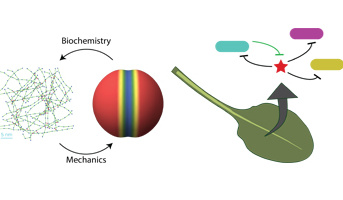Seminar: Marco Mauri
Structural properties of the bacterial cell wall & Bacterial leaf community in the presence of ITC toxin - Thursday, February 13th 2025, 11am
In this talk, I will explore two seemingly unrelated topics, demonstrating how simple mathematical and physical models can effectively describe and provide valuable insights into complex biological problems.
Structural properties of the bacterial cell wall
The bacterial cell wall, composed of the biopolymer peptidoglycan (PG), maintains cell shape, but its organization, particularly under antibiotic influence, remains unclear. Using high-resolution atomic force microscopy (AFM), we map PG organization across different cell regions and conditions. Mechanical parameters from these measurements inform a theoretical model of Staphylococcus aureus’ cell cycle, revealing that septum formation reduces mechanical stress near the septum and, under a stress-dependent enzyme activation hypothesis, predicts the timing of division phases.
We further extend AFM imaging to study PG organization under antibiotic treatment, complemented by dynamic simulations exploring how PG responds to mechanical and biochemical perturbations. Our findings link PG molecular configuration to cell wall mechanics, offering insights into how antibiotics disrupt PG organization and affect cell wall stability.
Bacterial leaf community in the presence of ITC toxin
Plant leaves host diverse microbial communities whose balance is crucial for plant health. Arabidopsis thaliana defend against pathogens by producing antimicrobial isothiocyanates (ITCs). While the pathogenic Pseudomonas species can degrade ITCs, commensals are typically unable and sensitive to the toxin. Understanding how ITC degradation affects leaf microbiome dynamics is key to advancing knowledge of plant disease resistance.
We investigated whether ITC-degrading Pseudomonas viridiflava (Ps) protects the bacterial leaf community from ITC toxicity by constructing artificial communities with either wild-type Ps or ITC-degradation-deficient mutant PsΔsaxA. Using a consumer-resource model incorporating ITC toxicity and degradation, we analyzed the community dynamics. Our findings reveal ITC and degrader thresholds that enable communal protection from ITC toxicity, highlighting the role of nutrient competition. Studying the defense system in A. thaliana enhances our understanding of plant-microbe interactions and offers valuable insights for modeling microbial communities.
Marco Mauri, Theoretical Microbial Ecology, University Jena, Jena, Germany
Invitation: Philippe Andrey, "Modeling and Digital Imaging" MiN team
In connection with the research developed at the Institute Jean-Pierre Bourgin for Plant Sciences.
Structural properties of the bacterial cell wall
The bacterial cell wall, composed of the biopolymer peptidoglycan (PG), maintains cell shape, but its organization, particularly under antibiotic influence, remains unclear. Using high-resolution atomic force microscopy (AFM), we map PG organization across different cell regions and conditions. Mechanical parameters from these measurements inform a theoretical model of Staphylococcus aureus’ cell cycle, revealing that septum formation reduces mechanical stress near the septum and, under a stress-dependent enzyme activation hypothesis, predicts the timing of division phases.
We further extend AFM imaging to study PG organization under antibiotic treatment, complemented by dynamic simulations exploring how PG responds to mechanical and biochemical perturbations. Our findings link PG molecular configuration to cell wall mechanics, offering insights into how antibiotics disrupt PG organization and affect cell wall stability.
Bacterial leaf community in the presence of ITC toxin
Plant leaves host diverse microbial communities whose balance is crucial for plant health. Arabidopsis thaliana defend against pathogens by producing antimicrobial isothiocyanates (ITCs). While the pathogenic Pseudomonas species can degrade ITCs, commensals are typically unable and sensitive to the toxin. Understanding how ITC degradation affects leaf microbiome dynamics is key to advancing knowledge of plant disease resistance.
We investigated whether ITC-degrading Pseudomonas viridiflava (Ps) protects the bacterial leaf community from ITC toxicity by constructing artificial communities with either wild-type Ps or ITC-degradation-deficient mutant PsΔsaxA. Using a consumer-resource model incorporating ITC toxicity and degradation, we analyzed the community dynamics. Our findings reveal ITC and degrader thresholds that enable communal protection from ITC toxicity, highlighting the role of nutrient competition. Studying the defense system in A. thaliana enhances our understanding of plant-microbe interactions and offers valuable insights for modeling microbial communities.
Marco Mauri, Theoretical Microbial Ecology, University Jena, Jena, Germany
Invitation: Philippe Andrey, "Modeling and Digital Imaging" MiN team
In connection with the research developed at the Institute Jean-Pierre Bourgin for Plant Sciences.
Back
